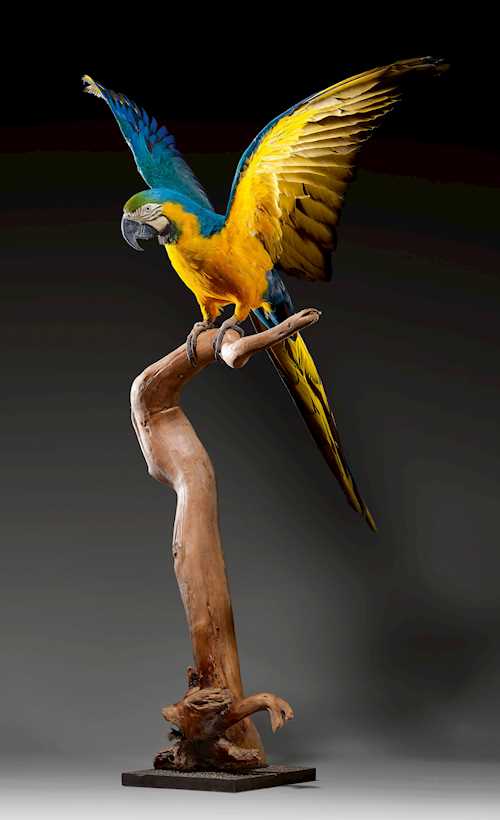
Lot 4021* ♣ - A209 Out of This World - Monday, 17. June 2024, 04.00 PM
BLUE AND YELLOW MACAW
Ara ararauna
2010 – 2020
114 × 72 × 76 cm (measurements including stand)
2010 – 2020
114 × 72 × 76 cm (measurements including stand)
For the exportation of this item a CITES license is required. Prospective buyers should familiarize themselves with relevant customs regulations prior to bidding if they intend to import this lot into another country. For further information please contact the department.
This blue-and-yellow breasted macaw is vividly presented. Perched on a branch with its wings spread wide, it evokes a sense of magic and grandeur. The parrot is in excellent condition and beautifully mounted. The blue-and-yellow macaw (Ara ararauna), also known as the blue-and-gold macaw, was first mentioned by Swedish naturalist Carl Linnaeus in 1758 in the tenth edition of his 'Systema Naturae'. The genus name means ‘macaw’ in the Brazilian Tupi language and the word is an onomatopoeia based on the sound of its call.
The macaw lives in the dense, lush forests of Mexico and in the Amazon rainforests of Brazil. Consequently, the preservation and protection of rainforests is critical to the macaw’s continued existence.
During the pre-Columbian Inca civilization, macaw feathers were highly sought after for their bright colours and were found at ceremonial and burial sites. Many tribes in Central and South America believed the macaw brought healing through colour and light. The macaw is also a symbol of sacred union and lasting relationships. This idea is rooted in the fact that macaws form pairs that mate for life.
This object was prepared after the animals natural demise in a Swiss Zoo.
The macaw lives in the dense, lush forests of Mexico and in the Amazon rainforests of Brazil. Consequently, the preservation and protection of rainforests is critical to the macaw’s continued existence.
During the pre-Columbian Inca civilization, macaw feathers were highly sought after for their bright colours and were found at ceremonial and burial sites. Many tribes in Central and South America believed the macaw brought healing through colour and light. The macaw is also a symbol of sacred union and lasting relationships. This idea is rooted in the fact that macaws form pairs that mate for life.
This object was prepared after the animals natural demise in a Swiss Zoo.
CHF 2 500 / 3 500 | (€ 2 580 / 3 610)
Sold for CHF 2 375 (including buyer’s premium)
All information is subject to change.






